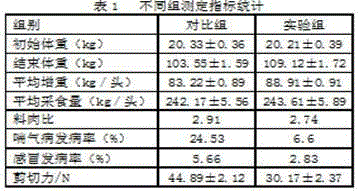Biological fermentation pig forage and preparation method thereof
A technology of biological fermentation and pig feed, applied in the field of livestock breeding, can solve problems such as poor nutrition, poor cold protection, and weakened resistance
- Summary
- Abstract
- Description
- Claims
- Application Information
AI Technical Summary
Problems solved by technology
Method used
Image
Examples
Embodiment 1
[0021] Example 1: a. After mixing 1.2 kilograms of Lactobacillus fermentum, 1.4 kilograms of Aspergillus niger, 1.8 kilograms of Lactobacillus plantarum and 1.8 kilograms of Lactobacillus johnsonii, they were added to 124 kilograms of 30 ~ 35 ℃ pure water, stir well;
[0022] b. Mix 38 kg of soybean meal, 38 kg of barley distiller's grains, 19 kg of wheat bran, 11 kg of euglena, and 3.5 kg of sea gold sand, and add ZD universal grinder (Jiangyin Xiangfei Powder Engineering Machinery Co., Ltd.) to grind and mix evenly. Then add the mixture in step a, stir evenly, and keep it at 30-35°C for 5-7 days;
[0023] c. After pulverizing 9 kilograms of rice chaff, mix them evenly with 48 kilograms of corn flour, 3.5 kilograms of konjac glucomannan, and 3.5 kilograms of glucosamine sulfate, and then add them to the mixture in step b. Keep at 38°C for 3 to 4 days;
[0024] d. Mix 0.22 kg of sodium selenosulfate, 3.5 kg of vitamin E acetate, and 11 kg of illite powder with a particle siz...
Embodiment 2
[0025] Example 2: a. After mixing 1 kg of Lactobacillus fermentum, 1 kg of Aspergillus niger, 1.5 kg of Lactobacillus plantarum, and 1.5 kg of Lactobacillus johnsonii, according to the weight ratio of 1: Add the ratio of 20 to pure water at 30-35°C, and stir evenly;
[0026] b. Mix 35 kg of soybean meal, 35 kg of barley distiller's grains, 17 kg of wheat bran, 10 kg of euglena, and 3 kg of sea gold sand. After pulverizing with a universal grinder, add the mixture in step a. Under the condition of ℃, keep it for 5-7 days;
[0027] c. After pulverizing 8 kilograms of rice stalks, mix them with 45 kilograms of corn flour, 3 kilograms of konjac glucomannan, and 3 kilograms of glucosamine sulfate, and then add them to the mixture in step b. Keep at 38°C for 3 to 4 days;
[0028] d. Mix 0.2 kg of sodium selenosulfate, 3 kg of vitamin E acetate, 10-12 kg of illite powder, and the mixture in step c evenly, dry and pack into bags.
Embodiment 3
[0029] Example 3: a. After mixing 1.5 kilograms of Lactobacillus fermentum, 1.5 kilograms of Aspergillus niger, 2 kilograms of Lactobacillus plantarum and 2 kilograms of Lactobacillus johnsonii, they were added to 140 kilograms of 30 ~ 35 ℃ pure water, stir well;
[0030] b. Mix 40 kg of soybean meal, 40 kg of barley distiller's grains, 25 kg of wheat bran, 13 kg of euglena, and 4 kg of sea gold sand. After pulverizing with a universal grinder, add the mixture in step a and stir evenly. Under the condition of ℃, keep it for 5-7 days;
[0031] c. After pulverizing 10 kilograms of rice champignons, mix them evenly with 53 kilograms of corn flour, 4 kilograms of konjac glucomannan, and 4 kilograms of glucosamine sulfate, and then add them to the mixture in step b. Keep at 38°C for 3 to 4 days;
[0032] d. Mix 0.3 kg of sodium selenosulfate, 4 kg of vitamin E acetate, and 12 kg of illite powder with the mixture in step c, dry and pack in bags.
PUM
| Property | Measurement | Unit |
|---|---|---|
| Particle size | aaaaa | aaaaa |
Abstract
Description
Claims
Application Information
 Login to View More
Login to View More - R&D
- Intellectual Property
- Life Sciences
- Materials
- Tech Scout
- Unparalleled Data Quality
- Higher Quality Content
- 60% Fewer Hallucinations
Browse by: Latest US Patents, China's latest patents, Technical Efficacy Thesaurus, Application Domain, Technology Topic, Popular Technical Reports.
© 2025 PatSnap. All rights reserved.Legal|Privacy policy|Modern Slavery Act Transparency Statement|Sitemap|About US| Contact US: help@patsnap.com

